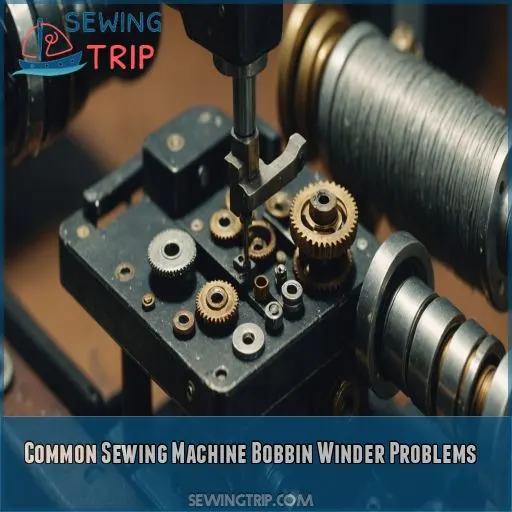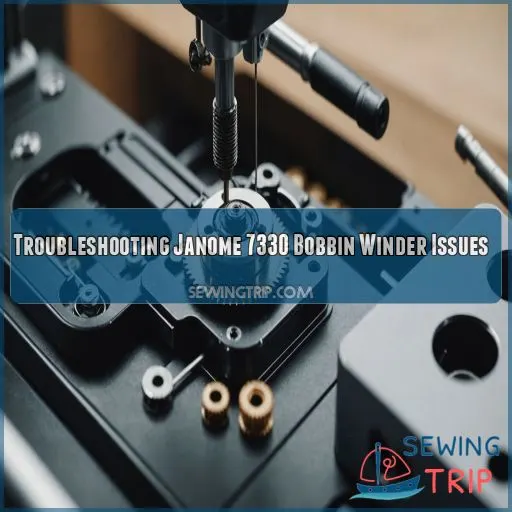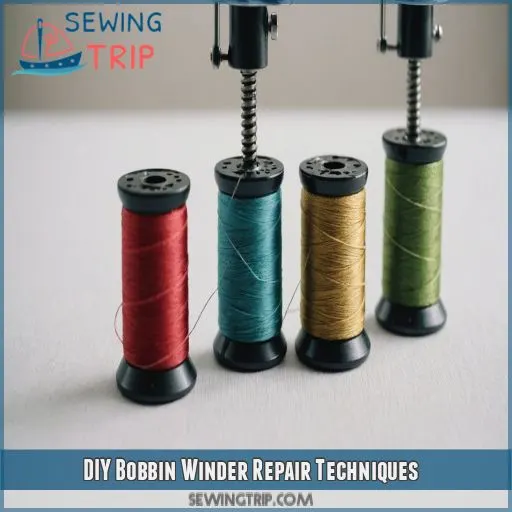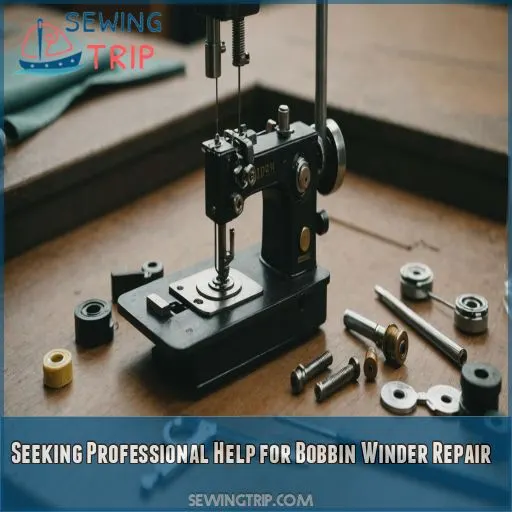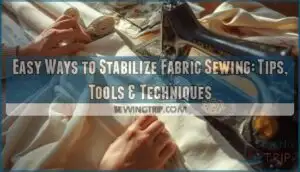This site is supported by our readers. We may earn a commission, at no cost to you, if you purchase through links.
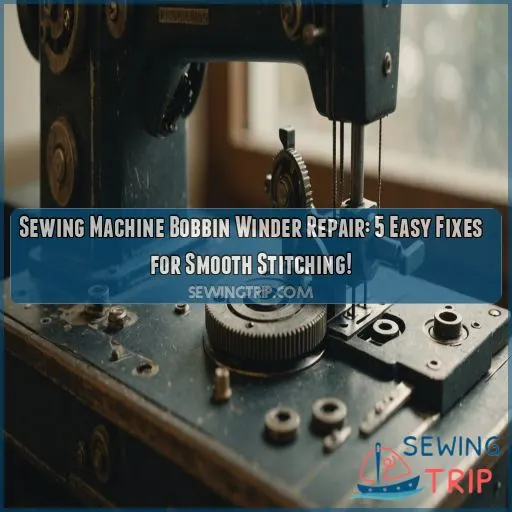 Tackling Sewing Machine bobbin winder repair can be a real thread-saver!
Tackling Sewing Machine bobbin winder repair can be a real thread-saver!
You’ll find that most issues stem from a few common culprits: broken winders, non-spinning spindles, or uneven winding.
Don’t let these hiccups unravel your sewing dreams!
Start by inspecting for visible damage and ensuring proper engagement.
If you’re feeling brave, you can even attempt DIY fixes like disengaging the needle bar or replacing the winder itself.
But remember, if you’re in over your head, there’s no shame in seeking expert help.
With a little patience and know-how, you’ll have your bobbin winder humming along in no time.
And who knows? You might just discover some unexpected tricks up your sleeve…
Table Of Contents
Key Takeaways
- You’ll find that most bobbin winder issues stem from a few usual suspects: broken winders, non-spinning spindles, or uneven winding. Don’t let these hiccups unravel your sewing dreams! Start by giving your machine a once-over, checking for visible damage and proper engagement. It’s like playing detective with your trusty sewing companion.
- When troubleshooting, remember it’s not rocket science – just a bit of patience and elbow grease. Check if your bobbin is seated correctly, the winder is engaged, and the thread is on the right path. If your bobbin is looking like a lopsided pancake, guide the thread with your finger for even filling. You’ll be winding perfect bobbins faster than you can say "stitch witch"!
- Don’t be afraid to roll up your sleeves and attempt some DIY fixes. You can disengage the needle bar to reduce wear and tear, or even replace the winder itself if it’s beyond repair. However, if you’re feeling out of your depth, there’s no shame in seeking expert help. It’s like knowing when to call a plumber instead of flooding your bathroom!
- Keep your bobbin winder in tip-top shape with regular maintenance. Dust it off, oil the moving parts, and check for wear and tear. If your winder starts acting up, it might be time to replace the tire – generally every 1-2 years with regular use. With these tricks up your sleeve, you’ll keep your sewing projects humming along smoothly.
Common Sewing Machine Bobbin Winder Problems
Is your sewing machine’s bobbin winder giving you grief? Don’t worry – we’ll tackle five common bobbin winder problems and show you how to fix them, so you can get back to stitching in no time.
Broken Bobbin Winder
Is your bobbin winder on the fritz?
Don’t let it unravel your sewing plans!
You can tackle this DIY repair with a bit of elbow grease.
Unplug your machine, flip it over, and remove the base screws.
Carefully detach the old winder using a small screwdriver or needle-nose pliers.
Then, gently install the new one without damaging your trusty sewing companion.
It’s easier than threading a needle in the dark!
Non-Spinning Spindle
If your bobbin winder‘s giving you the silent treatment, don’t throw in the towel just yet!
A non-spinning spindle is often caused by insufficient pressure between the bobbin tire and balance wheel.
It’s like a dance partner with cold feet.
Try loosening the adjustment screw, give the bobbin winder a gentle nudge closer to the balance wheel, and tighten it back up.
Voila! You’re back in the swing of things.
Uneven Bobbin Winding
Is your bobbin looking like a lopsided pancake? Don’t worry, we’ve all been there! Uneven bobbin winding can throw a wrench in your sewing plans, but it’s an easy fix. Here are four quick tips to get your bobbin back on track:
- Use the right bobbin for your machine
- Thread through the bobbin winder tension disk
- Guide the thread with your finger for even filling
- Adjust your winding speed
With these tricks, you’ll be winding perfect bobbins faster than you can say "stitch witch"!
Bobbin Popping Out
Now, let’s tackle another pesky problem: the bobbin popping out. It’s like your sewing machine’s playing a game of "catch me if you can"!
First, make sure you’re using the right bobbin size for your machine.
Check that it’s inserted correctly and the bobbin case isn’t damaged.
If your bobbin’s cracked or the winding’s too tight, it might be time for a replacement.
Proper alignment is key to keeping that little rascal in place!
Thread Bunching, Looping, or Tangling
Is your sewing machine turning into a tangled mess? Don’t throw in the towel just yet! Thread bunching, looping, or tangling (also known as "birdnesting") can be a real headache, but it’s often an easy fix. Here are some quick troubleshooting tips to get you back on track:
- Adjust the upper thread tension
- Double-check your threading path
- Make sure your bobbin’s inserted correctly
Troubleshooting Janome 7330 Bobbin Winder Issues
Is your Janome 7330’s bobbin winder giving you trouble? Don’t fret – we’ve got some simple troubleshooting steps to help you get your machine back in action.
Inspecting for Visible Damage
Now that we’ve covered common bobbin winder issues, let’s zero in on the Janome 7330.
First things first: give your bobbin winder a once-over.
Look for any cracks, broken springs, or loose screws.
Check if the spindle’s bent or if any parts are missing.
It’s like playing detective with your sewing machine!
A keen eye now can save you headaches later.
Ensuring Proper Engagement
Now that you’ve checked for visible damage, let’s make sure your bobbin winder‘s engaged properly.
It’s like getting your ducks in a row – everything needs to line up just right.
On your Janome 7330, look for the bobbin winder shaft and make sure it’s in the correct position.
If it’s not engaging, give it a gentle nudge.
Checking Bobbin Winder Tire
Now, let’s tackle that pesky bobbin winder tire! It’s like the unsung hero of your Janome 7330. Here’s what you need to do:
- Inspect the tire for signs of wear or damage
- Clean the tire with a soft cloth to remove lint and debris
- Check if the tire is properly aligned with the handwheel
- Test the tire’s tension by gently pressing it against the handwheel
If you spot any issues, don’t fret! A replacement tire might be just the ticket to get your bobbin winder humming again.
Examining Handwheel and Clutch
If the bobbin winder tire checks out, it’s time to turn your attention to the handwheel and clutch.
These parts are like the heart of your Janome 7330.
Give the handwheel a spin – it should move smoothly without any hitches.
If it’s sticking or feeling tight, you might need to lubricate the clutch.
Don’t worry, it’s not as hard as it sounds!
Identifying Internal Mechanical Problems
If your bobbin winder is still playing hide-and-seek, it’s time to peek under the hood.
Gearbox issues, spring tension hiccups, or bearing wear might be the culprits.
Don’t forget to check for motor failure or clutch problems too.
It’s like solving a mechanical puzzle!
Grab your Janome 7330 manual and channel your inner detective.
If you’re feeling out of your depth, don’t sweat it; a pro can help you crack the case.
4 Best Bobbin Winders for Sewing Machines
Is your sewing machine’s bobbin winder giving you headaches? Don’t worry – we’ve got some great options for you, with our top picks for the best bobbin winders that’ll make your sewing life a breeze.
1. Automatic Bobbin Winder for Sewing Machines
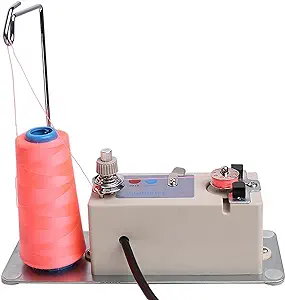
You’ll love this automatic bobbin winder! It’s a game-changer for your sewing projects. Compatible with various bobbin styles, it’ll wind your threads in a jiffy. The high-speed motor with auto-stop function means you can set it and forget it – no more babysitting your bobbins! Just pop it on your sewing table, adjust the tension, and you’re good to go. It’s like having a tiny robot assistant for your sewing machine. Keep in mind, though, it mightn’t play nice with delicate plastic bobbins. But for most projects, it’s a real time-saver!
Best For: This automatic bobbin winder is best for sewers who want to save time and increase efficiency with their sewing projects.
- High-speed motor with auto-stop function for hands-free winding.
- Compatible with various bobbin styles, making it versatile for different sewing machines.
- Easy to use with simple start and stop buttons.
- May not be compatible with all bobbin types, especially delicate plastic bobbins.
- Some users reported issues with thread tension and noise level.
- Instructions may require additional research or adjustments for optimal performance.
2. Automatic Bobbin Winder Sewing Machine
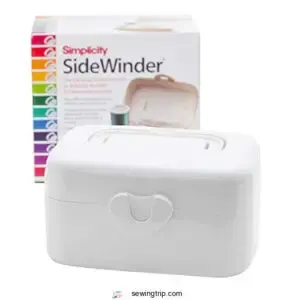
You’ll love the Simplicity Automatic Bobbin Winder – it’s a game-changer for your sewing projects! This nifty gadget winds bobbins in a flash, saving you time and hassle. No more re-threading your machine just to wind a bobbin! It’s portable, so you can take it anywhere, and it even shuts off automatically when the bobbin’s full. While it’s not compatible with every machine out there, it’ll work like a charm for most. Just keep in mind that some users find the plastic feels a bit flimsy, but hey, it gets the job done!
Best For: The Simplicity Automatic Bobbin Winder is best for sewers who want a fast and convenient way to wind bobbins without having to re-thread their sewing machine.
- Winds bobbins quickly and evenly
- Portable and easy to use
- Automatic shut-off feature
- Some users find the plastic construction to be flimsy
- Not compatible with all bobbin types
- Some users have reported uneven bobbin winding
3. Shark Pet Pro Plus Handheld Vacuum
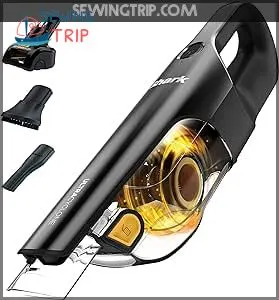
You’re probably wondering how a handheld vacuum made this list. Well, the Shark Pet Pro Plus isn’t just for pet hair – it’s a secret weapon for sewing enthusiasts! Its powerful suction can clean up thread snippets and fabric dust in a flash. The self-cleaning brush is perfect for tackling stubborn lint on your sewing table. Plus, at just 2.8 lbs, it’s light enough to maneuver around your machine without breaking a sweat. The crevice tool is a lifesaver for those hard-to-reach nooks in your sewing area. Just remember, it’s best for quick cleanups due to its short battery life.
Best For: Sewing enthusiasts and crafters looking for a lightweight, portable vacuum to quickly clean up thread snippets, fabric dust, and lint in their workspace.
- Powerful suction with two cyclonic air streams for effective cleanup of small debris
- Self-cleaning Pet Power Brush eliminates hair wrap and tackles stubborn lint
- Lightweight (2.8 lbs) and portable design with useful attachments for hard-to-reach areas
- Short battery life limits use to quick cleanup tasks
- Some users report issues with durability, particularly with plastic parts
- Customer service can be difficult to reach, with email as the only contact method
4. BLACK+DECKER Cordless Handheld Vacuum

You might be wondering, "What’s a vacuum got to do with bobbin winders?" Well, hear me out! The BLACK+DECKER Cordless Handheld Vacuum is a game-changer for keeping your sewing space spick and span. With its lightweight design and crevice tool, you’ll easily zap up stray threads and fabric scraps. The cyclonic action keeps suction strong, while the high-capacity dirt bowl means less emptying. Sure, it’s not a bobbin winder per se, but a clean workspace is key to smooth sewing. Plus, it’s a handy helper for quick cleanups between projects!
Best For: The BLACK+DECKER Cordless Handheld Vacuum is best for sewers and crafters who need a lightweight, portable vacuum for quick cleanups of fabric scraps and stray threads.
- Lightweight and easy to maneuver
- Crevice tool for reaching tight spaces
- Cyclonic action for consistent suction power
- Battery life can be inconsistent
- Dirt bowl can be difficult to clean thoroughly
- Limited attachment options
DIY Bobbin Winder Repair Techniques
Is your sewing machine’s bobbin winder giving you grief? Don’t fret – with these DIY repair techniques, you’ll have your trusty machine winding bobbins like a pro in no time.
Disengaging the Needlebar
Now that you’ve got the lowdown on bobbin winders, let’s talk about the needle bar.
This little dynamo’s always on the move, but sometimes you need it to take a breather.
By disengaging it, you’ll save your machine some wear and tear during bobbin winding.
It’s like giving your sewing buddy a mini-vacation!
Here’s how to do it without breaking a sweat.
Situating the Bobbin Correctly
Now that you’ve disengaged the needlebar, let’s tackle bobbin placement. It’s like fitting a puzzle piece – get it right, and you’re golden. Here’s your cheat sheet for situating the bobbin correctly:
- Align the bobbin slot with the spindle notch
- Hold the bobbin tire for better grip
- Check for smooth rotation
- Make sure the tension is right
- Wind in the correct direction
Ensuring Correct Threading
To start threading your bobbin winder, begin at the spool. Guide the thread around the top faceplate guide.
Next, move the thread down to the bottom guide, then up through the forked bit in front of the spindle.
Finally, thread the thread inside the bobbin and out the left side. This process is similar to playing connect-the-dots with your sewing machine.
Replacing the Bobbin Winder
If your bobbin winder’s beyond repair, don’t throw in the towel just yet! Replacing it might be easier than you think. With a little elbow grease and the right tools, you can breathe new life into your trusty sewing companion. Here’s what you need to know:
- Check compatibility: Not all winders fit all machines
- Gather your tools: Screwdriver, pliers, and patience
- Budget wisely: Parts can range from $10 to $50
- Follow the manual: Each machine’s a unique puzzle
Using a Stand-alone Bobbin Winder
If replacing the bobbin winder seems too hard, don’t give up just yet!
A stand-alone bobbin winder might be your knight in shining armor.
These nifty gadgets are like personal assistants for your bobbins, freeing up your machine for other tasks.
They’re a breeze to set up and can be a real game-changer, especially if you’re working on a vintage beauty that’s seen better days.
Seeking Professional Help for Bobbin Winder Repair
When DIY fixes just won’t cut it, it’s time to call in the pros for your bobbin winder woes. Whether you’re seeking online expert advice or hunting down vintage parts, we’ll help you get your sewing machine back in tip-top shape.
Online Expert Services
When your bobbin winder has you in a twist, online experts can be your knight in shining armor.
These virtual helpers are like having a sewing guru in your pocket, ready to untangle your troubles.
But before you jump in, consider the platform costs and expert credibility.
It’s important to find a trustworthy service that won’t leave you feeling stitched up.
Just Answer Platform Benefits
When your bobbin winder is giving you grief, Just Answer can be a real lifesaver.
You’ll get quick responses from sewing experts, saving you time and money.
Whether you’re working on a vintage Singer or a modern machine, these pros have got your back.
It’s like having a sewing guru in your pocket – available 24/7, ready to help you untangle any thread-related troubles!
Verification Process for Experts
When seeking expert help, you want to make sure you’re getting advice from the real deal.
Platforms like Just Answer put their experts through the wringer, verifying credentials and licenses with a fine-toothed comb.
It’s not just a quick glance at a resume – they use third-party validation to double-check everything.
Finding Vintage Sewing Machine Parts
Now that you’ve got the lowdown on expert verification, let’s hunt for those elusive vintage sewing machine parts. It’s like a treasure hunt for crafty folks! You’ll find a goldmine of options on eBay, but don’t forget to:
- Check seller ratings and feedback
- Compare prices across multiple listings
- Look for detailed item descriptions and photos
- Ask sellers about compatibility with your machine
- Join online forums for restoration tips and part recommendations
Work-from-Home Expert Opportunities
Looking to turn your sewing expertise into a side hustle?
Online platforms like Just Answer are always on the hunt for verified experts to help folks troubleshoot their bobbin winder woes.
It’s a win-win: you get to flex your knowledge from the comfort of your home, while sewers get their machines back in tip-top shape.
Plus, with growing demand, you might just stitch together a tidy income!
Frequently Asked Questions (FAQs)
Why is my sewing machine not winding the bobbin?
You’re not alone in this bobbin-winding woe! Check if your bobbin’s properly seated, the winder’s engaged, and the thread’s correctly threaded. Worn tires or a misaligned spindle could also be the culprits. Don’t let it unravel you!
Why is my bobbin stuck on bobbin winder?
Your bobbin’s stuck? Don’t sweat it! Check if it’s the wrong size or jammed with thread. Maybe the winder’s not fully engaged or the tire’s worn out. Give it a gentle wiggle and inspect for any debris.
How do you tighten a bobbin winder?
To tighten a bobbin winder, locate the adjustment screw near the base. Turn it clockwise to increase pressure against the handwheel. Test as you go – you’ll want it snug but not too tight. It’s like finding Goldilocks’ perfect porridge!
How do you get the thread out of a bobbin winder?
You’ll want to gently unwind the thread from the bobbin winder. Hold the bobbin steady and rotate it counterclockwise, guiding the thread off. If it’s stuck, use tweezers to carefully loosen any tangled bits. Easy peasy!
How do I clean and maintain my bobbin winder?
You’ll want to regularly dust off your bobbin winder and oil its moving parts. Gently wipe it down with a soft cloth, and use a small brush to remove lint. Don’t forget to check for wear and tear!
Can I use a universal bobbin winder for different machines?
You bet your bottom dollar you can! Universal bobbin winders are like the Swiss Army knives of sewing. They’ll work with most machines, but double-check compatibility. It’s a handy gadget that’ll save you time and hassle across your sewing arsenal.
What causes a bobbin winder to wind unevenly?
You’re facing uneven bobbin winding? It’s usually due to incorrect threading, tension issues, or a wonky bobbin. Check your thread path, adjust the tension, and make sure you’re using the right bobbin. A steady hand helps too!
How often should I replace my bobbin winder tire?
You’ll know it’s time when your bobbin winder starts acting up. Generally, replace the tire every 1-2 years with regular use. If you’re a sewing machine whisperer, you might squeeze out more time!
Are there aftermarket upgrades for bobbin winder mechanisms?
Like a turbo for your sewing engine, aftermarket upgrades for bobbin winders exist. You’ll find magnetic winders, auto-stop mechanisms, and even digital counters. These nifty add-ons can supercharge your sewing experience, making bobbin winding a breeze.
Conclusion
Mastering sewing machine bobbin winder repair is like gaining a superpower for seamstresses!
You’ve now got the know-how to tackle common issues, from broken winders to uneven winding.
Don’t be afraid to get your hands dirty with DIY fixes, but know when to call in the pros.
With these tips in your sewing arsenal, you’ll keep your projects running smoothly.

